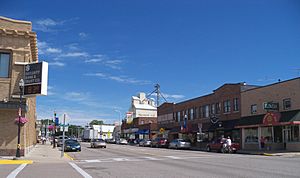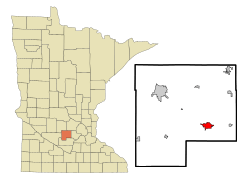Glencoe, Minnesota facts for kids
Quick facts for kids
Glencoe, Minnesota
|
|
|---|---|

Downtown Glencoe
|
|
| Motto(s):
"Small City, Big Future"
|
|

Location in McLeod County and the state of Minnesota
|
|
| Country | United States |
| State | Minnesota |
| County | McLeod |
| Area | |
| • Total | 3.17 sq mi (8.21 km2) |
| • Land | 3.17 sq mi (8.20 km2) |
| • Water | 0.01 sq mi (0.02 km2) |
| Elevation | 1,001 ft (305 m) |
| Population
(2020)
|
|
| • Total | 5,744 |
| • Density | 1,814.85/sq mi (700.81/km2) |
| Time zone | UTC-6 (Central (CST)) |
| • Summer (DST) | UTC-5 (CDT) |
| ZIP code |
55336
|
| Area code(s) | 320 |
| FIPS code | 27-23948 |
| GNIS feature ID | 2394912 |
Glencoe is a city in Minnesota, United States. It is the main town, or county seat, of McLeod County. In 2020, about 5,744 people lived there. Glencoe is known for its friendly community.
Contents
A Look Back in Time
Glencoe started as a town in 1855. It was named after a beautiful place called Glen Coe in Scotland. A year later, in 1856, Glencoe got its own post office. This helped people send and receive letters. Glencoe officially became a city in 1909.
Where is Glencoe Located?
Glencoe is in the southeastern part of McLeod County. A major road, U.S. Route 212, goes through the south side of the city. This road connects Glencoe to other towns. For example, it's about 11 miles east to Norwood Young America. It's also about 29 miles west to Hector. The big city of Minneapolis is about 54 miles to the east.
Another important road, Minnesota State Highway 22, runs through the middle of Glencoe. This highway leads northwest about 14 miles to Hutchinson. Hutchinson is the biggest city in McLeod County. Highway 22 also goes south-southwest about 17 miles to Gaylord.
Land and Water Features
Glencoe covers an area of about 3.17 square miles (8.21 square kilometers). Most of this area is land. Only a tiny part, about 0.01 square miles (0.02 square kilometers), is water. Buffalo Creek flows through the south side of the city. This creek is part of the Crow River system. The Crow River eventually flows into the mighty Mississippi River.
Who Lives in Glencoe?
| Historical population | |||
|---|---|---|---|
| Census | Pop. | %± | |
| 1880 | 1,078 | — | |
| 1890 | 1,649 | 53.0% | |
| 1900 | 1,780 | 7.9% | |
| 1910 | 1,788 | 0.4% | |
| 1920 | 1,747 | −2.3% | |
| 1930 | 1,925 | 10.2% | |
| 1940 | 2,387 | 24.0% | |
| 1950 | 2,801 | 17.3% | |
| 1960 | 3,216 | 14.8% | |
| 1970 | 4,217 | 31.1% | |
| 1980 | 4,396 | 4.2% | |
| 1990 | 4,648 | 5.7% | |
| 2000 | 5,453 | 17.3% | |
| 2010 | 5,631 | 3.3% | |
| 2020 | 5,744 | 2.0% | |
| U.S. Decennial Census | |||
In 2010, about 5,631 people lived in Glencoe. There were 2,220 homes, with many families living together. The city has a mix of different people. Most residents are White. There are also people from African American, Native American, and Asian backgrounds. A notable part of the population is of Hispanic or Latino heritage.
Many homes in Glencoe have children under 18. The average age of people in the city was about 37.7 years old. This means there's a good mix of young people, adults, and older residents.
Glencoe's Weather
Glencoe experiences all four seasons. Here's a quick look at the average temperatures and rainfall:
| Month | Jan | Feb | Mar | Apr | May | Jun | July | Aug | Sep | Oct | Nov | Dec | Year |
|---|---|---|---|---|---|---|---|---|---|---|---|---|---|
| Average High°F | 20 | 27 | 39 | 55 | 70 | 80 | 83 | 80 | 72 | 59 | 39 | 25 | 54 |
| Average Low°F | 1 | 8 | 21 | 34 | 47 | 57 | 62 | 59 | 48 | 36 | 22 | 8 | 34 |
| Average Precipitation " | 0.66 | 0.6 | 1.58 | 2.48 | 3.44 | 4.71 | 3.62 | 4.41 | 2.93 | 2.05 | 1.71 | 0.69 | 28.88 |
Glencoe in Film
Glencoe was featured in a documentary film called God's Country. The film was made by a French director named Louis Malle. He filmed it in 1979 and again in 1985. Many people from Glencoe were interviewed for the movie. This included a dairy farmer and banker named Clayton Hoese and his sons. The film showed what life was like in this small American town.
See also
 In Spanish: Glencoe (Minnesota) para niños
In Spanish: Glencoe (Minnesota) para niños

